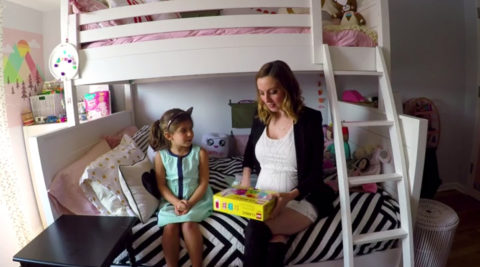Welcome to my new series— Big Kid Bedtime Problems! Certified sleep consultant Hadley Seward is going to help us sort through our issues. She will be addressing some of the specific sleep problems I talked about having with Mazzy and Harlow in a future post. Last week she introduced some general guidelines for parents of toddlers and up who find their nighttime routines spiraling out of control. Today, it’s all about specific tips and hacks for your bedtime routine.
————
Parenting is one of the toughest jobs around, never more so than at night. If you’re like most parents, short-term sleep solutions that once worked have become long-term bad habits that don’t work at all. Bedtime (and overnights) can quickly escalate to shouting matches or heart-wrenching emotional manipulations. “But I love you! Sooooo much! I just want you to lay in bed with me ALL. NIGHT. LONG!”
The struggle is real.
The first step? Admitting that you have a problem. If you’ve been following this series, you know that I strongly encourage you to define specific sleep rules for your child, which you introduce to them in advance. Once you’ve laid out the rules, it’s time to commit to them wholeheartedly. There’s no backing down now. If you say you won’t go back in the room, DON’T GO BACK IN. If you say that your child cannot sleep in your bed, return them to theirs. You’re playing to win. There will likely be tears (real or otherwise) but once they realize that you’re not budging, they’ll accept the new rules as the new normal.
Easier said than done, right!? Here are a few hacks I’ve collected over the years that can help you follow through on your sleep rules.
1) If your child refuses to stay in his bed (or his room)
If your child refuses to stay in his bed (or his room), your best bet is to try the silent return. On the surface it’s easy: return your child to his bed with ninja-like stealth each and every time he leaves the room. No negotiation, no drama, no yelling. Do not engage. It may initially take a LOT of returns to bed and will probably feel like it isn’t working. This is not the time to give up! Keep at it— with time and consistency, it will work.
2) If your child wants you to lay with him until he falls asleep
If your child wants you to lay with him until he falls asleep, the first question is: Do you want to? If so, go for it. But if you don’t want to, I recommend explaining that you will stay for X minutes but after that time is over, you will leave the room. Chose a time that works for you and stick to it. Use the timer on your phone and make those few minutes enjoyable. Once the timer goes off, say goodnight and leave the room. Do not come back. If your child gets out of bed and leaves the room, use the silent return method described above.
3) If your child keeps calling you back into the room after you’ve said goodnight
If your child keeps calling you back into the room after you’ve said goodnight, create three “tickets” that you give him each night at bedtime. Every time you need to go back into the room— whether it’s for that last glass of water or an extra kiss, he must surrender one of the tickets. When you get to the third ticket, remind him that it’s the last one. Once they’re all gone, don’t go back into the room. For real.
4) If you’re ready to transition your child from co-sleeping to sleeping in his own bed
If you’re ready to transition your child from co-sleeping to sleeping in his own bed, try the “camping out” method. Place a mattress on the floor next to his bed, which will be your bed for the next few nights. Over the course of 1-2 weeks, move the bed farther and farther away from his, until it’s at the bedroom door. This will help him adjust to sleeping in a separate space, but in order for this to work, he has to sleep in his bed… not on the mattress with you!
5) If your child insists that he doesn’t know how to fall asleep on his own
If your child insists that he doesn’t know how to fall asleep on his own, but you’d like him to, you may need to do some form of sleep training. Methods that work well for bigger kids are extinction (CIO), partial extinction (Ferber), and the chair method. See descriptions below:
Extinction: Once the child is fed and comfortable in his bed, the parent says goodnight and doesn’t go back in until the morning.
Timed Intervals: At bedtime and for each overnight wake-up, the parent waits for a pre-determined interval before doing a quick check. The intervals gradually increase over time.
Chair Method: The parent sits in a chair next to the child’s bed until he falls asleep and at each overnight wake-up. Every few days, the parents moves the chair further away from the bed, eventually out of the room.
Lastly, a note on the time your child goes to bed…
Almost every child with whom I’ve worked with was going to bed too late, which didn’t cause the underlying issues but certainly exacerbated them. Most kids, especially those who are no longer napping, need to be in bed (lights out!) between 7-8pm. I know from personal experience that it can be quite difficult to wrangle a child into bed at a decent hour, but you’d be surprised at how much it can improve sleep. And a well rested child is much happier child during the day, which is well worth the loss of quality time together at night.
Hadley Seward is the mama of two and a certified sleep consultant living in New York City. She works with exhausted parents to help their kids get more sleep. Meet her at @_bonnenuitbaby.


























GREAT advice! I will never regret hiring a sleep consultant. My 3.5 year old’s behavior has improved incredibly since we got him going to bed at an earlier time and without the crutches he had come to rely on.
I totally agree with changing behaviors that you want to change…. I’m fine with laying down with daughter (who is already 9!) for 5-10 minutes. It is a good snuggle session. But if that isn’t your thing, these are great recommendations to make changes – even for some older children.
What about the “I have to go potty” excuse? Particularly if he is actually going each time, even if it’s only a few drops? My 4 year old is going 3-4 times right at bedtime and I know it’s a stall tactic but when I try to say no and put him back in bed it’s like he becomes possessed. There’s no reasoning with him, if I just put him down and leave he’ll either cling to me so I can’t get out or follow me. An otherwise sweet boy is making me hate bedtime.
I m always wondering how you can put a child to bed at 7pm , when you come home from work at 7pm… which is the case for many parents ( at least in France )?
I managed the co-sleeping transition by renovating the room , explaining in advance (1 month ” when we will return from holiday , you will sleep in your bed “) and also using ” the magical feeder of courage “. So now bedtime is far from being perfect but she sleeps in her bed ( so , I consider it as a win for the moment 😀)
Great blog by the way !
I love the Silent Return technique! I had never heard of that before, but I’ll be trying it tonight with my three-year-old if need be.